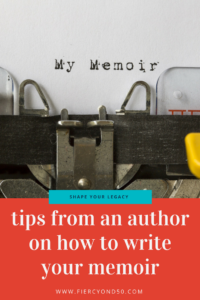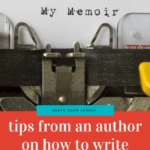This post may contain affiliate links. Full disclosure policy
THIS POST MAY CONTAIN REFERRAL LINKS. IF YOU CLICK THROUGH AND TAKE ACTION, I MAY BE COMPENSATED, AT NO ADDITIONAL COST TO YOU.
You’ve been thinking about it for a while now.
Maybe the sound of your most recent “speed limit” birthday (the kind that ends with a zero) whizzing past helped make up your mind.
Maybe it was the results of a study showing that an alarming percentage of millennials don’t know that JFK was a president as well as an airport and think that milk comes from a laboratory.
Or maybe you want your kids, or grandkids, or the world to understand how many mountains you had to climb to become who you are today.
Whatever the reason, you’ve decided to write your memoir.
Good decision!
But now that you’ve made up your mind, where do you begin?
Good question.
WHAT TO DO FIRST
If you haven’t already done so, I suggest you read my recent post, Should I Write My Memoir. Even though you’ve already made your decision, this post asks some important questions that will help you figure out some of the motivations, mechanics, and expectations of your memoir project.
If you’re looking to write a personal history to share with a small group of family or friends, you might not be terribly concerned with the art and craft of memoir writing. You just want to get the facts out there.
But whether you’re goal is to produce a 50 page, self-published collection of anecdotes to pass out at the family reunion or a 500 page tome that you believe has bestseller potential, I know you want to tell a good story.
But how?
If you’ve progressed much farther than chapter one, you’re already beginning to realize that this project might be trickier than you’d realized.
Accept the Struggle
Take heart, my Fierce Friend. Writing anything worthwhile – a novel, a memoir, or even really good letter to your pen pal – requires thought, effort, and possibly a certain amount of pain. As Hemmingway famously said, “There is nothing to writing. All you do is sit down at a typewriter and bleed.”
The fact that you’re struggling now doesn’t mean there is no hope. Struggle and self-doubt are part of the writing process. If you’re not struggling, you’re not writing. You might be spelling, but you’re not writing.
Here’s the good news.
Whatever the size or scope of your writing endeavor, the focused application of a few basic tips will make your writing more interesting. And possibly even riveting.
The real trick to writing a riveting memoir is to approach it like a novel. Tell a story that hooks readers from page one and makes them want to keep turning those pages to find out how it all turns out.
These six secrets of great storytelling will point you in the right direction.
START IN THE MIDDLE
Yes, you read that right. Start your memoir somewhere in the middle.
By opening your story at a particularly dramatic or meaningful moment in your life you will instantly grab your reader’s interest. You’ll also help them start wondering how all this happened and where it is going.
If the first few pages of your story starts filling the reader’s mind with questions they want answers to, you’re on the road to writing a page-turning memoir. Once you’ve raised all those interesting questions, your reader will happily follow you back to the beginning to search for the answers.
DON’T GIVE AWAY THE ENDING
Having plopped your reader smack dab in the middle of a dramatic and/or exciting scene, don’t grab defeat from the jaws of victory by telling the reader how the story turns out.
For example, let’s say the first scene in your memoir takes place at the Boston marathon.
It’s mile 20 of the race. You’re tired but running well. Even though Heartbreak Hill is in sight, you feel confident you can take it. After all, this is only one of many hills you’ve tackled in your life – illness, injury, divorce, poverty, self-doubt. You can do this! You’ve worked so long and hard to get to this moment!
Then, the unexpected happens. Another runner zooms past, accidentally knocks you off balance. You fall onto the pavement. You try to get up but there’s a gash on your leg and you’re in terrible pain. Other runners, people who you already passed, are streaming by, leaving you behind. Tears come to your eyes. It hurts so much. You’re not sure you can go on.
This is not the moment to say, “That’s what I was thinking and feeling on the day I completed my first marathon and ultimately took third place in my age group.”
Tease the story out, scene by scene and chapter by chapter. Let the heroine (in this case, you) struggle and triumph (briefly) then fall back into trials. Take your reader along for each bump and twist of the rollercoaster ride.
You can hint at a happy or heartbreaking ending to come, but don’t give it away.
Nobody likes a spoiler!
SHOW, DON’T TELL
Mark Twain once said, “Don’t say the old lady screamed. Bring her on and let her scream.”
That, in a nutshell, is the difference between showing and telling. And showing versus telling is the difference between a boring book and a compelling one.
Instead of saying, “My mother suffered from debilitating depression,” demonstrate her depression and its impact on the family. Show a day you came home from school to find her laying in bed with her face to the wall, your baby sister crying in her crib, the sink full of unwashed dishes.
Instead of saying, “My father was a generous man,” show a day when you were going downtown to buy some badly needed shoes. Have him meet up with a man who has lost his job. Have your dad quietly slip him the ten dollars that was intended for his shoes. When you voice your concern about the holes in his boots, have him say, “I can patch them again.”
Whenever you have an opportunity to show what happened, do. It will make your story sparkle!
BE BRUTALLY HONEST WITHOUT BEING BRUTAL
Obviously, the scenes I outlined above were entirely fictional.
You’ll need to delve into your own memory banks in search of moments that vividly demonstrate your point or highlight the personalities of the characters involved. It’s all right to take a bit of literary license, especially when it comes to dialogue, but try to stick to the truth as much as possible.
In addition to being truthful, be honest. Delve deep into the good, bad, and ugly of your story. Be willing to share failures and well as success, tragedies as well as triumph.
Be raw. Be human. Be transparent.
At the same time, be careful.
Every story has heroes and villains. So does every family. But think carefully before you go around naming names and pointing fingers.
Sometimes, it’s a good idea to change the names, places, or even the timing to protect the innocent. Or even the guilty.
DON’T PREACH
Unless it’s Sunday and they went to church by choice, most people don’t care to be preached at.
Though imparting life lessons might be one of the reasons you wanted to write your memoir, if you start getting preachy, your reader is probably going to close the book.
Instead of telling the reader that hard work and a positive attitude will pay off eventually, demonstrate the principal by setting up scenes and relating anecdotes that prove the point and letting your reader
Don’t brag. Don’t explain. Don’t teach. Don’t preach.
Set up the scenes, let them play out, and trust that your reader is smart enough to get the point.
CUT OUT THE BORING PARTS
Alfred Hitchcock, the great film director, said, “What is drama but life with the boring bits cut out.”
Realism minus the boring parts is a principle that I’ve always tried to adhere to when writing my novels. It’s just as important if you’re writing a memoir.
As you’re writing, keep your audience in mind. Always consider what they need to know and want to know. Don’t include anything – a scene, description, genealogical record, or anything else – that doesn’t meet that standard.
Bringing in detail is important; they make the scenes and personalities in your story vivid and real. But you should never include a detail for the sake of detail.
No matter how beautifully written it might be, if it doesn’t move the story forward, illustrate character, or support the theme, it doesn’t need to be there.
Don’t bore your reader with extraneous detail. Keep the drama, and the story, moving.
START STRONG
Obviously, applying these 6 tips to your writing is just a jumping off point, a good beginning. Writing a good memoir takes time, effort, and study.
Consider taking a class on writing creative non-fiction or memoir through your local community college or online.
You might also want to read some books on the art and craft of writing memoir. There are some excellent suggestions near the end of my recent post about my favorite memoirs and autobiographies.
Reading a few of those memoirs is a good idea too. There’s no better way to learn about the principals of good storytelling than by actually reading good stories!
And remember, sharing your memoir, whether it’s for your own enjoyment, for your friends and family, or for the NY Times Best-seller list, is an amazing way to share with the world what you’ve learned so far.
We’ve got at least five decades of wisdom to share and it would be a shame, perhaps even selfish, to keep that to ourselves!
Am I right?





